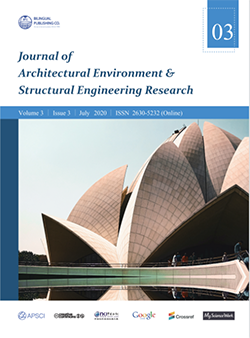-
379
-
230
-
191
-
190
-
178
Prospects of Partial Substitution of Cement with Rice Husk Ash for Road Concrete Works
DOI:
https://doi.org/10.30564/jaeser.v3i3.2223Abstract
Rice Husk Ash (RHA) has been found as a potential partial replacement for cement in concrete. This study attempts to make an evidence based evaluation of the sustainability and benefits of RHA utilisation as partial replacement of cement in road concrete works within Anambra State of Nigeria. The ashes of the rice husks collected from different locations were characterised. Direct interviews were conducted among the rice mill personnel and experts in the construction companies. The values of SiO2 + Fe2O3 + Al2O3 for the four analysed RHA samples ranged from 78.9% to 80.3% as revealed by the X-ray fluorescence analysis. This confirms that they are pozzolanic. The highest observed 28th day compressive strength of concrete was 41.8 N/mm2 for the concrete containing 10% RHA. Beyond the 10% replacement level, the compressive strength dropped below the control values. The result of the Analytical Hierarchy Process (AHP) analysis displayed the highest option preference of 40.3% for utilising RHA in road construction. These show that utilising RHA for road concrete works would be a sustainable option. 10% replacement of cement with RHA was recommended for optimum performance based on the compressive strengths of the tested RHA based concretes.
Keywords:
Analytical hierarchy process; Concrete; Pozzzolanic; Rice husk ash; Road works; SustainableReferences
[1] N.C. Madu, C.C. Joshua, U.J. Nwachukwu, Influence of Spatial Variation in Subgrade Properties on the Design of Highway Flexible Pavements, American Journal of Applied Scientific Research 2(6) (2016) 65-74.
[2] M. Rogers, B. Enright, Highway engineering, John Wiley & Sons2016.
[3] C. Maduabuchukwu Nwakaire, S. Poh Yap, C. Chuen Onn, C. Wah Yuen, H. Adebayo Ibrahim, Utilisation of recycled concrete aggregates for sustainable highway pavement applications; a review, Construction and Building Materials 235 (2020) 117444.
[4] D. Vijayan, S. Arvindan, T.S. Janarthanan, Evaluation of ferrock: a greener substitute to cement, Materials Today: Proceedings 22 (2020) 781-787.
[5] C. Marthong, Effect of rice husk ash (RHA) as partial replacement of cement on concrete properties, International Journal of Engineering Research & Technology 1(6) (2012) 1-9.
[6] N. Bheel, S.L. Meghwar, S. Sohu, A.R. Khoso, A. Kumar, Z.H. Shaikh, Experimental study on recycled concrete aggregates with rice husk ash as partial cement replacement, Civil Engineering Journal 4(10) (2018) 2305-2314.
[7] H. Mahmoud, Z. Belel, C. Nwakaire, Groundnut shell ash as a partial replacement of cement in sandcrete blocks production, International Journal of Development and sustainability 1(3) (2012) 1026-1032.
[8] Z. Zhao, F. Xiao, S. Amirkhanian, Recent applications of waste solid materials in pavement engineering, Waste Management 108 (2020) 78-105.
[9] S. Ramesh, S. Kavitha, Experimental study on the behaviour of cement concrete with rice husk ash (RHA), Int. J. Eng 6(02) (2014) 8269.
[10] G.A. Habeeb, H.B. Mahmud, Study on properties of rice husk ash and its use as cement replacement material, Materials research 13(2) (2010) 185-190.
[11] A.K. Anupam, P. Kumar, G. Ransinchung, Use of various agricultural and industrial waste materials in road construction, Procedia-Social and Behavioral Sciences 104 (2013) 264-273.
[12] D. Shrivastava, A. Singhai, R. Yadav, Effect of lime and rice husk ash on engineering properties of black cotton soil, International Journal of Engineering and Innovative Technology 3(2) (2014) 292-296.
[13] M.A. Rahman, M. Imteaz, A. Arulrajah, M.M. Disfani, Suitability of recycled construction and demolition aggregates as alternative pipe backfilling materials, Journal of Cleaner Production 66 (2014) 75-84.
[14] R. Krishna, P. Admixtures, Rice husk ash–an ideal admixture for concrete in aggressive environments, Magnesium (as MgO) 1(1.35) (2012) 0.35.
[15] S. Mishra, S. Deodhar, Effect of rice husk ash on cement mortar and concrete, New Building Materials and Construction World 13 (2013) 224-227.
[16] M.S. Ismail, A. Waliuddin, Effect of rice husk ash on high strength concrete, Construction and building materials 10(7) (1996) 521-526.
[17] S. Becker, A. Bryman, H. Ferguson, Understanding Research for Social Policy and Social Work 2E: Themes, Methods and Approaches, policy press2012.
[18] T.L. Saaty, That is not the analytic hierarchy process: what the AHP is and what it is not, Journal of Multi‐Criteria Decision Analysis 6(6) (1997) 324-335.
[19] G. Coyle, The Analytic Hierarchy Process (AHP). Practical Strategy: Structured Tools and Techniques. Open Access Material, Glasgow: Pearson Education Ltd, 2004.
[20] C.M. Nwakaire, J. Keirstead, Assessing the sustainability of meat transport mode choices in abattoir logistics using the analytic hierarchy process, ARPN Journal of Engineering and Applied Sciences 10(20) (2015) 9331-9338.
[21] J. Keirstead, M. Leach, Bridging the gaps between theory and practice: a service niche approach to urban sustainability indicators, Sustainable Development 16(5) (2008) 329-340.




 Chidozie Maduabuchukwu Nwakaire
Chidozie Maduabuchukwu Nwakaire






